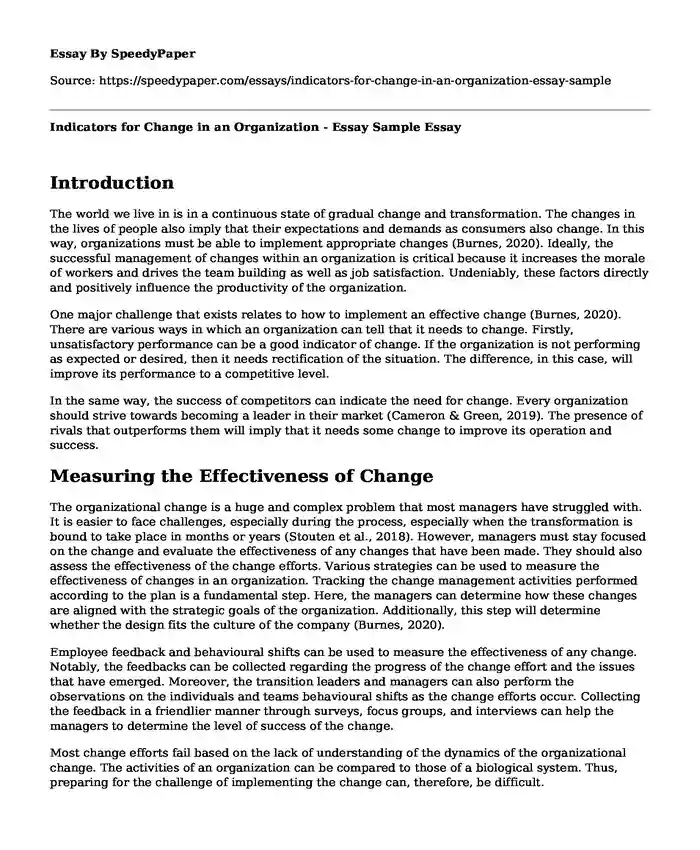
| Type of paper: | Essay |
| Categories: | Strategic management Business management |
| Pages: | 3 |
| Wordcount: | 700 words |
Introduction
The world we live in is in a continuous state of gradual change and transformation. The changes in the lives of people also imply that their expectations and demands as consumers also change. In this way, organizations must be able to implement appropriate changes (Burnes, 2020). Ideally, the successful management of changes within an organization is critical because it increases the morale of workers and drives the team building as well as job satisfaction. Undeniably, these factors directly and positively influence the productivity of the organization.
One major challenge that exists relates to how to implement an effective change (Burnes, 2020). There are various ways in which an organization can tell that it needs to change. Firstly, unsatisfactory performance can be a good indicator of change. If the organization is not performing as expected or desired, then it needs rectification of the situation. The difference, in this case, will improve its performance to a competitive level.
In the same way, the success of competitors can indicate the need for change. Every organization should strive towards becoming a leader in their market (Cameron & Green, 2019). The presence of rivals that outperforms them will imply that it needs some change to improve its operation and success.
Measuring the Effectiveness of Change
The organizational change is a huge and complex problem that most managers have struggled with. It is easier to face challenges, especially during the process, especially when the transformation is bound to take place in months or years (Stouten et al., 2018). However, managers must stay focused on the change and evaluate the effectiveness of any changes that have been made. They should also assess the effectiveness of the change efforts. Various strategies can be used to measure the effectiveness of changes in an organization. Tracking the change management activities performed according to the plan is a fundamental step. Here, the managers can determine how these changes are aligned with the strategic goals of the organization. Additionally, this step will determine whether the design fits the culture of the company (Burnes, 2020).
Employee feedback and behavioural shifts can be used to measure the effectiveness of any change. Notably, the feedbacks can be collected regarding the progress of the change effort and the issues that have emerged. Moreover, the transition leaders and managers can also perform the observations on the individuals and teams behavioural shifts as the change efforts occur. Collecting the feedback in a friendlier manner through surveys, focus groups, and interviews can help the managers to determine the level of success of the change.
Most change efforts fail based on the lack of understanding of the dynamics of the organizational change. The activities of an organization can be compared to those of a biological system. Thus, preparing for the challenge of implementing the change can, therefore, be difficult.
Summary of Kurt Lewin’s Three-Stage Model
Kurt Lewin change model involves three main steps. These include unfreezing, changing and refreezing. In the view of Lewin, the process of change consists of the creation of the perception that change is required, then advancing to the new, desired behaviour of level and finally cementing that new behaviour as a norm (Burnes, 2020). Lewin’s change management theory assists to account for both the uncertainty and the challenges that can be experienced by all employees within an organization (Cameron & Green, 2019).
It is critical to note that Lewin’s change model is still frequently utilised in the organizational change. Additionally, it can be used in team building approaches where it can play a critical part in bringing a change in mentality among the employees and establishing the awareness.
References
Burnes, B. (2020). The Origins of Lewin’s Three-Step Model of Change. The Journal of Applied Behavioral Science, 56(1), 32-59. http://dspace.stir.ac.uk/bitstream/1893/30461/1/A-Lewin%203-Step%20ModelV1%20Accepted%20Version.pdf
Cameron, E., & Green, M. (2019). Making sense of change management: A complete guide to the models, tools and techniques of organizational change. Kogan Page Publishers.
Stouten, J., Rousseau, D. M., & De Cremer, D. (2018). Successful organizational change: Integrating the management practice and scholarly literatures. Academy of Management Annals, 12(2), 752-788. https://www.cebma.org/wp-content/uploads/Stouten-et-al-2018.pdf
Cite this page
Indicators for Change in an Organization - Essay Sample. (2023, Oct 31). Retrieved from https://speedypaper.com/essays/indicators-for-change-in-an-organization-essay-sample
Request Removal
If you are the original author of this essay and no longer wish to have it published on the SpeedyPaper website, please click below to request its removal:
- Essay Sample on Strategic Management and Knowledge Management Theory and Research
- Free Essay on Price Discrimination in Swiss International Airlines
- Essay Sample: Starbucks in 2012: Evolving into a Dynamic Global Organization
- Change Approach Essay Example
- Report on Having Full-Time Workers
- Amazon and Porter's Diamond Model, Business Essay Example
- Essay Sample on The Mission of the Company
Popular categories




